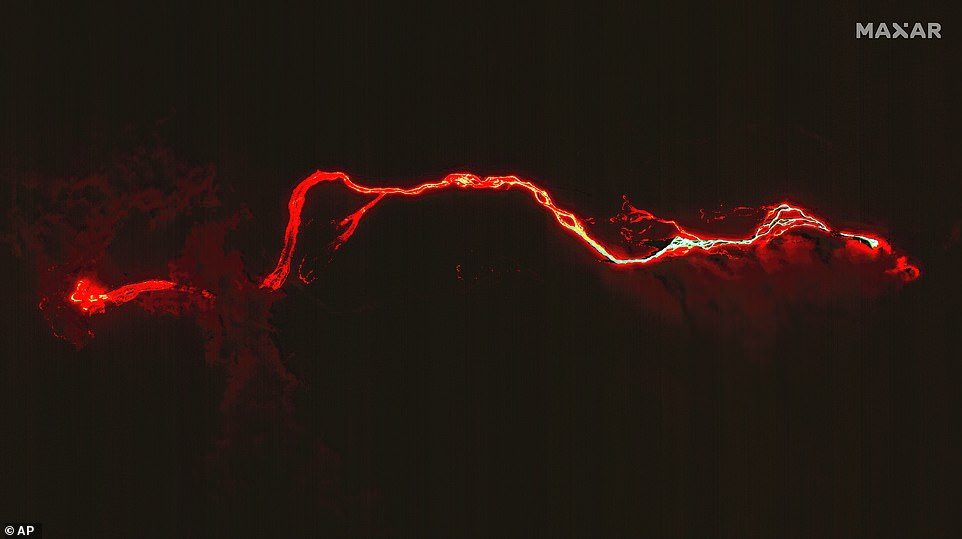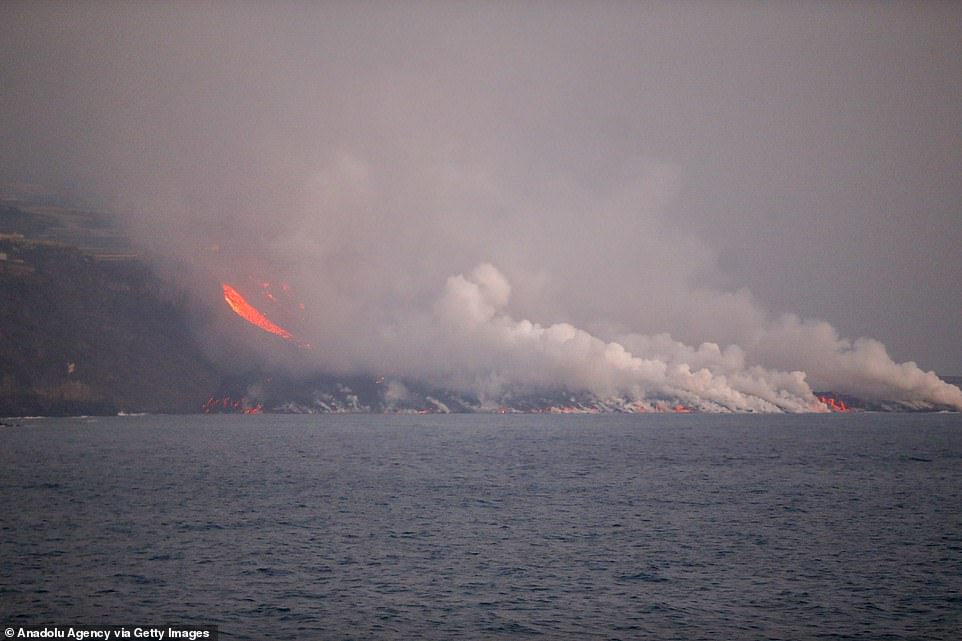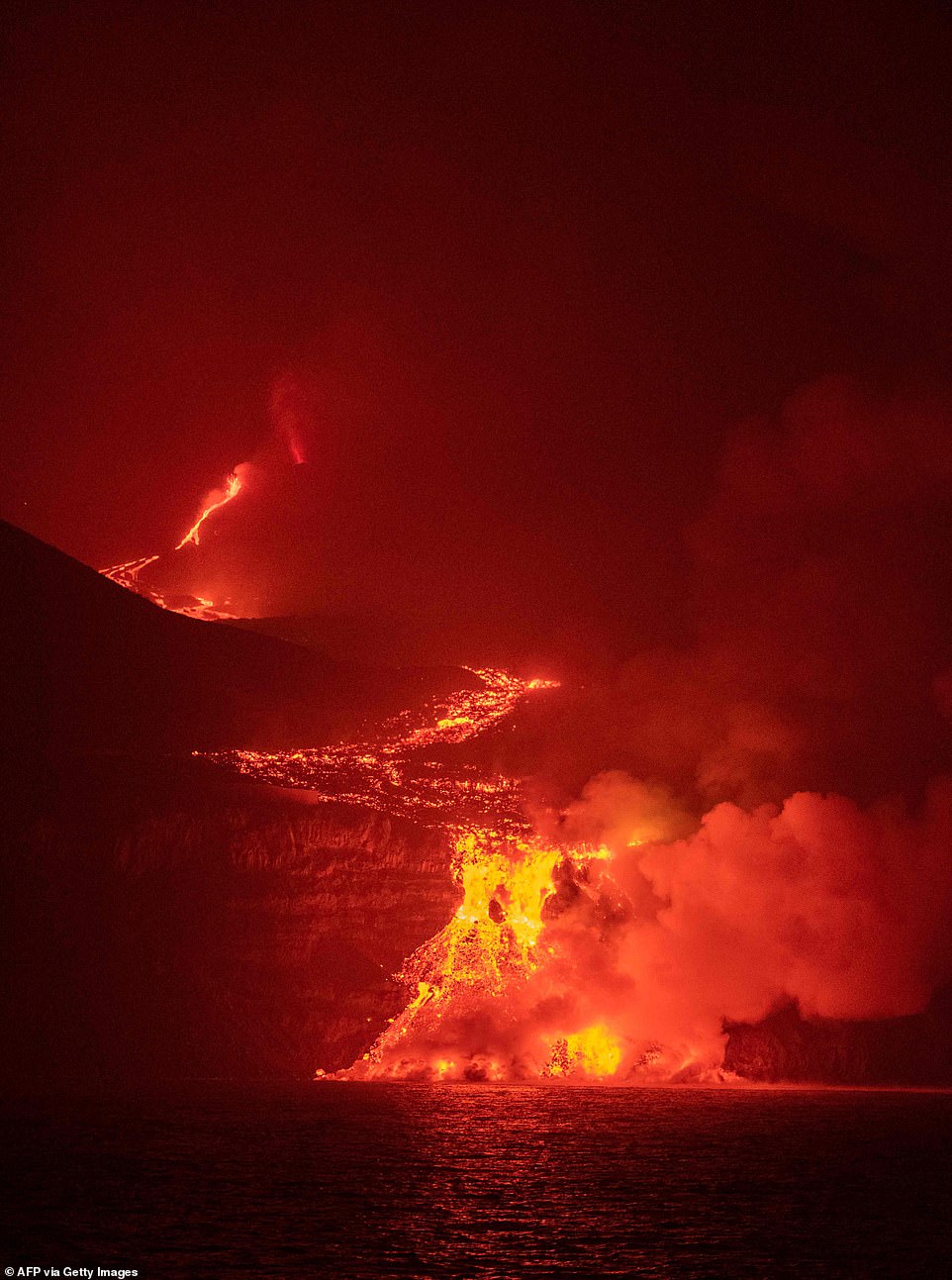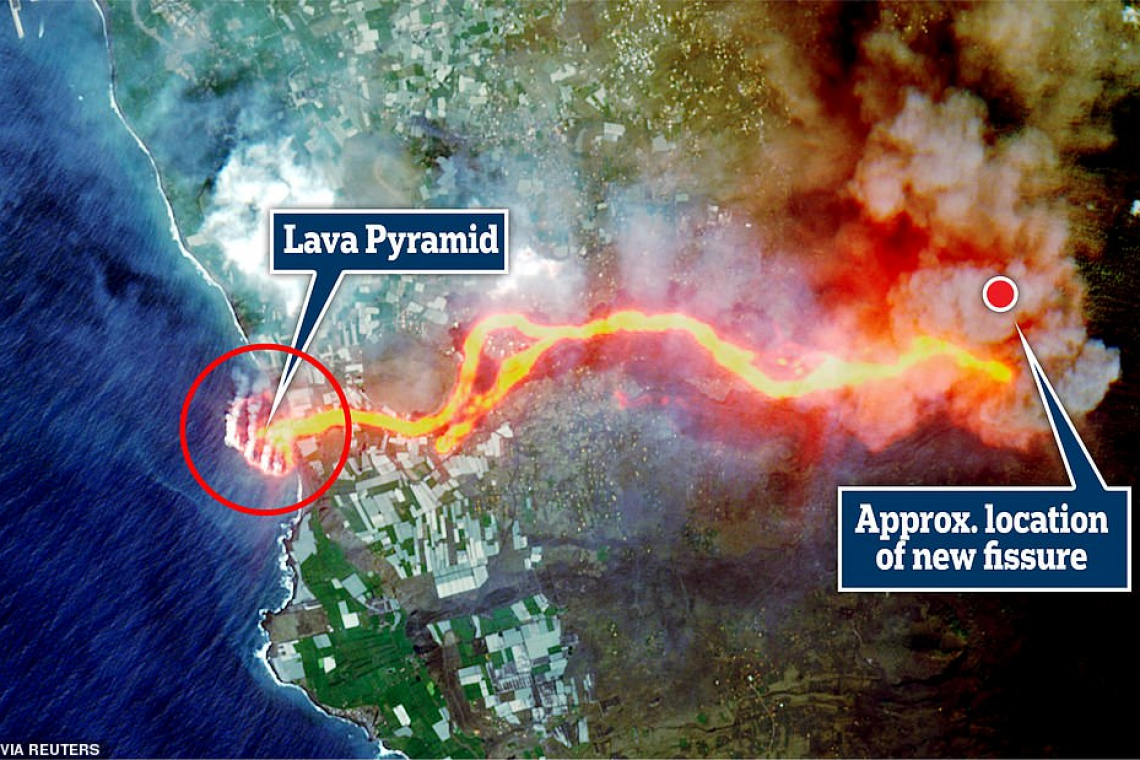
Incredible satellite images have shown how a river of lava weaving its way across the island of La Palma has formed a 550 yard-wide pyramid in the ocean after it erupted last month.
Meanwhile, a new fissure opened in the Cumbre Vieja volcano on Thursday, carving a different path from previous flows and raising fears of more destruction, while fine ash forced islanders to don masks and goggles.
As the lava from the volcano hardens when it comes into contact with water, the Spanish Canary Island found to the north-west of Africa is continuing to expand, scientists said earlier.
Since erupting on September 19, lava flowing from the volcano has destroyed more than 800 buildings, as well as banana plantations, roads and other infrastructure.
After meandering downhill to the coast for nearly 10 days, the lava reached the ocean just before midnight on Tuesday, less than a mile west of Tazacorte.
On reaching the water, the lava cools rapidly, binding to the cliffside and enlarging the island's territory and has created a rocky outcrop more than 546 yards wide.
Copernicus, the European Union's Earth observation programme, said on Thursday that its satellite imagery showed a D-shaped tongue of molten rock building up on the island's western shore measured 338 hectares (835 acres) by the end of Wednesday.
Release of the satellite images came as lava flowed from a newly opened vent on Friday, carving a different path down the side of the island, and raising fears of even greater damage than that already caused.
A river of red-hot lava snaked downhill from the new fissure, which burst open late on Thursday around 1,300 ft to the north of the primary eruption site.
Multiple vents have opened since the volcano began erupting on Sept. 19 but the Canaries Volcanology Institute described the latest opening as a new 'focus of eruption'.
'There is concern about the path of this new flow towards the sea, although it is expected to join up with the previous one within the next few hours,' said the head of La Palma's council, Mariano Hernandez Zapata.
He said more houses had been engulfed by lava overnight.
'We have more drama ahead, more people to take care of,' he told a news conference.


About 6,000 people have been evacuated since the eruption began and are yet to return home. More than 800 buildings including houses, churches and schools have been destroyed.
The volcano has thrown out 80 million cubic metres of molten rock, regional leader Angel Victor Torres said, doubling the amount expelled during La Palma's last major eruption 50 years ago in half the time.
Residents of Los Llanos de Aridane, one of the worst affected towns, have taken to carrying umbrellas and wearing eye protection as a precaution against the volcanic dust blanketing the streets and floating in the air.
'Last night the ash was irritating my eyes a lot, I had to use eye drops and my skin was stinging,' said Matilde Gonzalez Tavarez, a 45-year-old nursing assistant visiting her mother at a care home in Los Llanos.
'It's helplessness, fear, insecurity. You don't know what's going to happen,' she said, while street cleaners brushed away the carpet of black ash behind her.
Juan Antonio Perez Gonzalez, 56, who runs a floristry business in the town, fears the worst is yet to come.
'I can't put a good face on it or give you good news because this is a calamity,' he told Reuters. He said many of the townspeople were preparing to pack up and leave.
Trade winds typical of Spain's Canary Islands were helping dispel the plumes of water vapour and toxic gases that result when the lava, with a temperature of over 1,000C (1,800F), meets the ocean, where the water is 22C (71.6F).
But authorities were on alert as Spain's weather forecaster, AEMET, indicated that the wind's direction could change later on Thursday and bring the toxic plumes towards the shore and further inland.
The hydrochloric acid and tiny particles of volcanic glass released into the air can cause skin, eye and respiratory tract irritation.
The direction the lava flow could take was also a source of concern.
Molten fluid emanating from the volcano that first erupted on September 19 was still running downhill like a river and tumbling over a cliff into the Atlantic.
But uneven terrain could make the lava overflow its current path, spread to other areas, and destroy more houses and farmland.
At least 855 buildings and 19 miles (30km) of roads, as well as other key infrastructure, have been wiped out so far.
Banana plantations that are the source of income for many islanders have also been either destroyed or damaged by volcanic ash.

Residents of Spain's La Palma were struggling on Thursday to come to terms with the devastation wrought by the Cumbre Vieja volcano, which has been ejecting a destructive cocktail of ash, smoke and lava for more than 10 days.
La Palma resident Carmen Rodriguez, who lost her home in the village of Todoque, was caught off guard by the advancing column of molten rock and was struggling on Thursday to come to terms with the devastation.
'We never thought that the volcano was going to reach our house, never,' she said, recalling how she rushed to salvage belongings during a last-minute evacuation before the lava engulfed her home.
'There were so many people and difficulties, there was a queue. Thankfully we were able to take the washing machine, the fridge and a cooker that I recently bought.'
'I only ask that they give us a place to live, that they give us a habitable house, nothing more,' she said.
No casualties or injuries have been reported among La Palma residents since the eruption began.
La Palma, home to about 85,000 people, is part of the volcanic Canary Islands, an archipelago off northwest Africa. The island is roughly 22 miles (35km) long and 12 miles (20km) wide at its broadest point.



